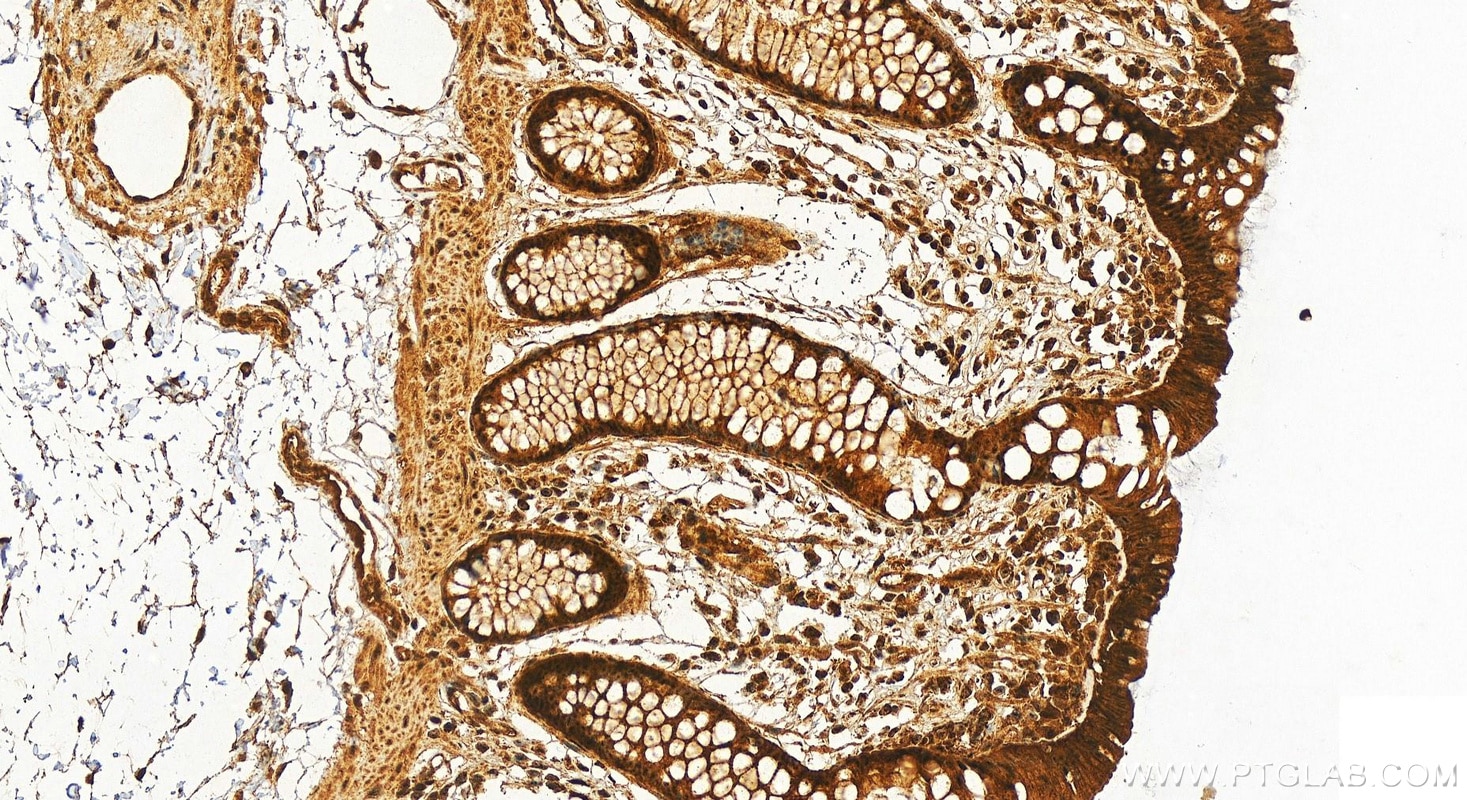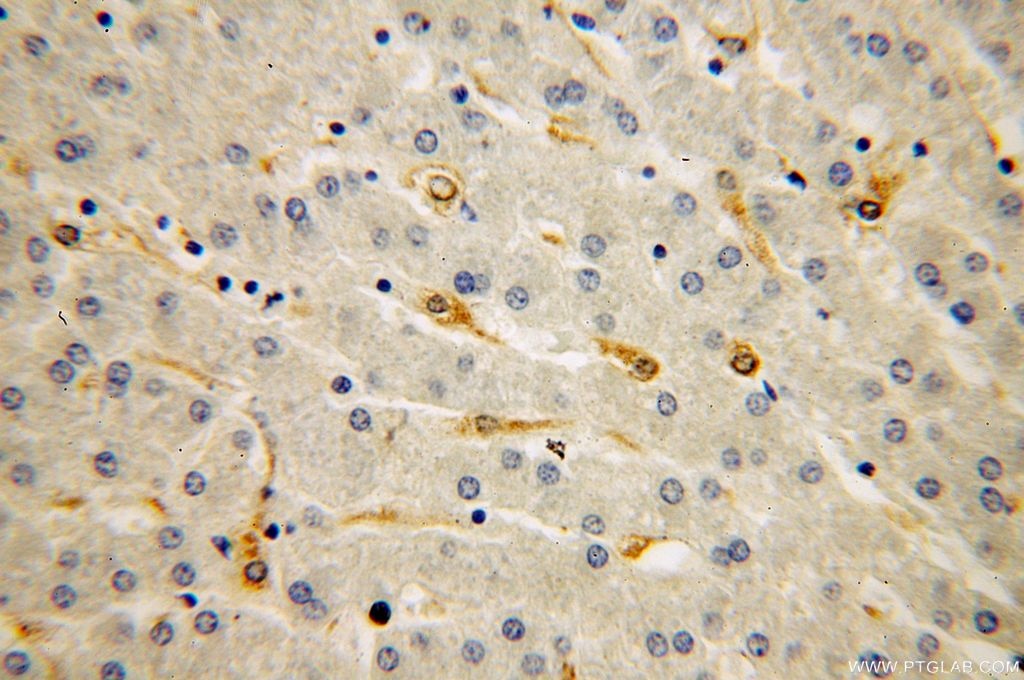Validation Data Gallery
Tested Applications
| Positive WB detected in | A549 cells, A431 cells, HEK-293 cells, PC-3 cells |
| Positive IP detected in | A549 cells |
| Positive IHC detected in | human colon tissue, human breast cancer tissue, human liver tissue Note: suggested antigen retrieval with TE buffer pH 9.0; (*) Alternatively, antigen retrieval may be performed with citrate buffer pH 6.0 |
| Positive IF/ICC detected in | A549 cells |
| Positive FC (Intra) detected in | MCF-7 cells |
Recommended dilution
| Application | Dilution |
|---|---|
| Western Blot (WB) | WB : 1:2000-1:10000 |
| Immunoprecipitation (IP) | IP : 0.5-4.0 ug for 1.0-3.0 mg of total protein lysate |
| Immunohistochemistry (IHC) | IHC : 1:50-1:500 |
| Immunofluorescence (IF)/ICC | IF/ICC : 1:200-1:800 |
| Flow Cytometry (FC) (INTRA) | FC (INTRA) : 0.40 ug per 10^6 cells in a 100 µl suspension |
| It is recommended that this reagent should be titrated in each testing system to obtain optimal results. | |
| Sample-dependent, Check data in validation data gallery. | |
Published Applications
| KD/KO | See 2 publications below |
| WB | See 80 publications below |
| IHC | See 12 publications below |
| IF | See 5 publications below |
| IP | See 2 publications below |
Product Information
17509-1-AP targets IRS1 in WB, IHC, IF/ICC, FC (Intra), IP, Dot blot, ELISA applications and shows reactivity with human samples.
| Tested Reactivity | human |
| Cited Reactivity | human, mouse, rat, pig, megalobrama amblycephala |
| Host / Isotype | Rabbit / IgG |
| Class | Polyclonal |
| Type | Antibody |
| Immunogen |
CatNo: Ag11714 Product name: Recombinant human IRS1 protein Source: e coli.-derived, PGEX-4T Tag: GST Domain: 895-1243 aa of BC053895 Sequence: EYVNIEFGSDQSGYLSGPVAFHSSPSVRCPSQLQPAPREEETGTEEYMKMDLGPGRRAAWQESTGVEMGRLGPAPPGAASICRPTRAVPSSRGDYMTMQMSCPRQSYVDTSPAAPVSYADMRTGIAAEEVSLPRATMAAASSSSAASASPTGPQGAAELAAHSSLLGGPQGPGGMSAFTRVNLSPNRNQSAKVIRADPQGCRRRHSSETFSSTPSATRVGNTVPFGAGAAVGGGGGSSSSSEDVKRHSSASFENVWLRPGELGGAPKEPAKLCGAAGGLENGLNYIDLDLVKDFKQCPQECTPEPQPPPPPPPHQPLGSGESSSTRRSSEDLSAYASISFQKQPEDRQ 相同性解析による交差性が予測される生物種 |
| Full Name | insulin receptor substrate 1 |
| Calculated molecular weight | 1242 aa, 132 kDa |
| Observed molecular weight | 160-185 kDa |
| GenBank accession number | BC053895 |
| Gene Symbol | IRS1 |
| Gene ID (NCBI) | 3667 |
| RRID | AB_10596914 |
| Conjugate | Unconjugated |
| Form | |
| Form | Liquid |
| Purification Method | Antigen affinity purification |
| UNIPROT ID | P35568 |
| Storage Buffer | PBS with 0.02% sodium azide and 50% glycerol{{ptg:BufferTemp}}7.3 |
| Storage Conditions | Store at -20°C. Stable for one year after shipment. Aliquoting is unnecessary for -20oC storage. |
Background Information
Ins receptor substrate 1 (IRS1) was the first cloned and characterized member of the IRS family which are involved in ins receptor (IR) and ins-like growth factor I receptor (IGF-IR) signaling. IRS1 is phosphorylated by ins receptor tyrosine kinase and is involved in various cellular processes including DNA repair fidelity, transcriptional activity, and cell growth can support tumor development and progression. Mutations in this gene are associated with type II diabetes and susceptibility to ins resistance. IRS1 has a predicted molecular weight of 132 kDa, however, as a result of its extensive serine phosphorylation it separates on a SDS gel as a band of approximately 160-185 kDa.
Protocols
| Product Specific Protocols | |
|---|---|
| IF protocol for IRS1 antibody 17509-1-AP | Download protocol |
| IHC protocol for IRS1 antibody 17509-1-AP | Download protocol |
| IP protocol for IRS1 antibody 17509-1-AP | Download protocol |
| WB protocol for IRS1 antibody 17509-1-AP | Download protocol |
| Standard Protocols | |
|---|---|
| Click here to view our Standard Protocols |
Publications
| Species | Application | Title |
|---|---|---|
Cell Metab Augmentation of scleral glycolysis promotes myopia through histone lactylation | ||
Mol Cell KARATE: PKA-induced KRAS4B-RHOA-mTORC2 supercomplex phosphorylates AKT in insulin signaling and glucose homeostasis | ||
Autophagy BNIP3L/Nix-induced mitochondrial fission, mitophagy, and impaired myocyte glucose uptake are abrogated by PRKA/PKA phosphorylation. | ||
Environ Health Perspect Effects of Chronic Secondhand Smoke (SHS) Exposure on Cognitive Performance and Metabolic Pathways in the Hippocampus of Wild-Type and Human Tau Mice. | ||
JHEP Rep Human umbilical cord mesenchymal stem cell-derived exosomes ameliorate liver steatosis by promoting fatty acid oxidation and reducing fatty acid synthesis | ||
Int J Biol Macromol Lycium barbarum polysaccharide mitigates high-fat-diet-induced skeletal muscle atrophy by promoting AMPK/PINK1/Parkin-mediated mitophagy |













